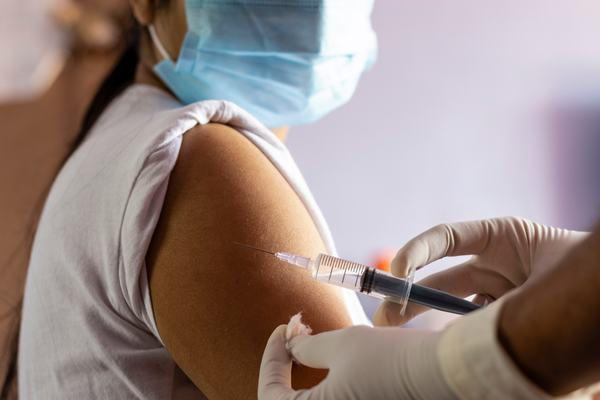Supply Chain • 6 min read
How Vaccines Are Preserved At Different Stages of the Supply Chain?

Aman P.
Dec 30, 2022
When it comes to our health, we trust that the vaccines that we need are of better quality. But how can we be sure? We don’t have the whole manufacturing process at our fingertips. So we decided to clarify important steps in the process and what they involve.

Blog Outline –
- How are Vaccines Stored?
- What are the most common storage conditions?
- Setting the Stage: A Fragile Medical Supply Chain
- Potential Problems and Challenges
- The vaccine supply chain can be broken down into three distinct stages
- What steps can be taken?
The World Health Organization estimates that up to 50% of vaccines are wasted globally every year; a large part because of lack of temperature control and the logistics to support an unbroken cold-chain.
Storing vaccines is a growing concern for healthcare providers and patients alike. With more and more vaccines coming onto the market, it’s important to ensure that we have safe, reliable storage practices in place that protect against vaccine deterioration.
Vaccines are stored at different stages of the supply chain based on their age, potency and safety. They can last for years or even decades. However, there are some key points to consider when dealing with vaccines as they age:
- What is the shelf life of a vaccine?
- How are vaccines stored?
- How long do they need to be kept before use?
What are the most common storage conditions?
Vaccines are preserved at different stages in the supply chain, and these stages can have different storage requirements. At each stage, vaccines have a limited shelf-life. The length of time between manufacture and administration is known as the cold chain, which refers to temperature and moisture stability throughout this process.
Most vaccines should be stored at between 2-8 ℃ in a refrigerator, with a preferred average of 5℃, though some should remain frozen in a range between -15℃ and -50℃. Many live-virus vaccines can tolerate freezing temperatures and rapidly deteriorate once defrosted, while inactivated vaccines more commonly require stable temperatures of 2/8℃. Some 75-100% of vaccines are inadvertently exposed to freezing temperatures at some point in the cold chain, the time between manufacture and administration.
“A critical component of immunisation programme is the vaccine supply chain and cold chain -which play a key role in keeping vaccines safe and efficacious from the stage of manufacture to eventual delivery to the patient,“ an official with the National Cold Chain & Vaccine Management Resource Centre said.
Setting the Stage: A Fragile Medical Supply Chain
A medical supply chain is a complex and fragile system. It is susceptible to natural disasters, labour strikes, weather events and other disruptions that can cause disruption in the flow of products and services.
The supply chain is also vulnerable to human error. The complexity of the medical supply chain makes it difficult for an organization to identify potential issues before they affect patients. For example, a shipment may arrive in one state but not reach its destination because of a late driver or a problem at customs.
In recent years, there have been several high-profile incidents that have highlighted the fragility of the medical supply chain. In 2008, three months after Hurricane Katrina hit New Orleans and caused widespread damage, healthcare providers were forced to cancel surgeries and other procedures due to shortages of supplies brought in by emergency response teams from around the country.
Potential Problems and Challenges
- National security issues
- Shortage of personnel
- Lack of coordination
- Shortage of supplies
- Limited capacity
- Vaccine damage
- Gaps for rural areas
- Misinformation about vaccines and tracking
The vaccine supply chain can be broken down into three distinct stages:
Manufacturer – The vaccine manufacturer is responsible for creating and producing each batch of vaccine. They may also have a responsibility for testing the final product to ensure it meets regulatory standards. Manufacturers must be able to maintain strict control over their manufacturing process and ensure safety in all aspects of production.
Distributor – After a vaccine has been manufactured by a manufacturer, it must be distributed to healthcare providers who will administer it to patients. Vaccine distributors work closely with manufacturers to ensure that vaccines are received in good condition so that they can be safely administered to patients without compromising their potency or effectiveness.
Healthcare Provider – Healthcare providers are responsible for ensuring that each patient receives all vaccines needed for their immunization schedule
What steps can be taken?
Vaccines are preserved and stored at different stages of the supply chain.
The CDC recommends that each of the participants of the cold chain develop and maintain a thorough written plan for the ordering, acceptance, handling, and storage of such products, including accounting for emergency storage locations should there be a power outage or similarly urgent situation.
Several studies have highlighted key issues in vaccine storage, with the most commonly found errors including the storage of vaccines past their expiration date, deep freezers being too warm (-14℃ or higher), and refrigerators being too warm (over 8℃ ). Major risk factors have been identified, such as lacking a thermometer in freezers, and less commonly in refrigerators, or using a combination refrigerator/freezer, as the freezer compartment inside such devices keeps poor temperature homeostasis.
Vaccine wastage can occur during production or distribution through improper use or contamination during transport. Vaccine wastage may also occur if vaccines are not stored properly before use; this is referred to as vaccine wastage before use (WBU) or vaccine integrity (VI).
More articles

How Vaccines Are Preserved At Different Stages of the Supply Chain?
When it comes to our health, we trust that the vaccines that we need are of better quality. But how can we be sure? We don’t have the whole manufacturing process at our fingertips. So we decided to clarify important steps in the process and what they involve.
Read now • 6 min read

What You Need To Know About Vaccine Storage and Cold Chain?
Did you know that the right cold chain is critical for the long-term stability of freeze-dried vaccines? These are only some of the facts we explore in our article on how to ensure your vaccine supply is resilient.
Read now • 6 min read

If Not Us, Then Who? The Pharmaceutical Cold Chain Today and Tomorrow
In what ways is the pharmaceutical cold chain a crucial link in delivering pharmaceutical products to customers safely in developing countries? By extension, what is the role of the cold chain in meeting the goals of the WHO? What are the priorities and challenges?
Read now • 6 min read

